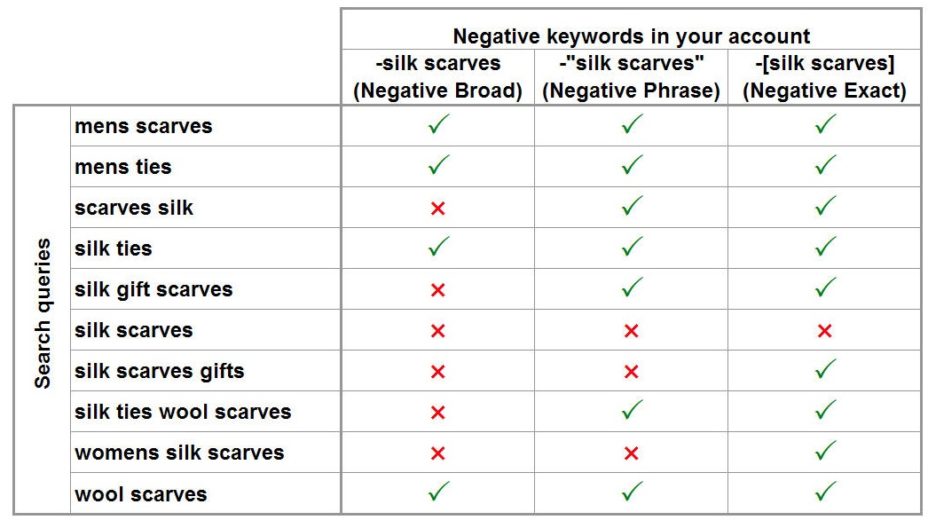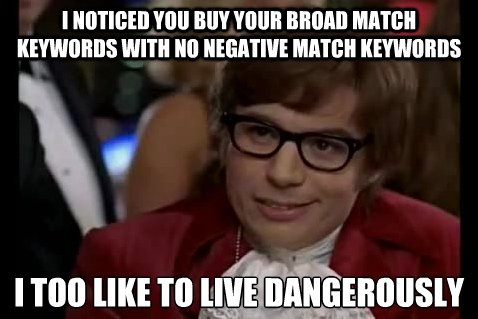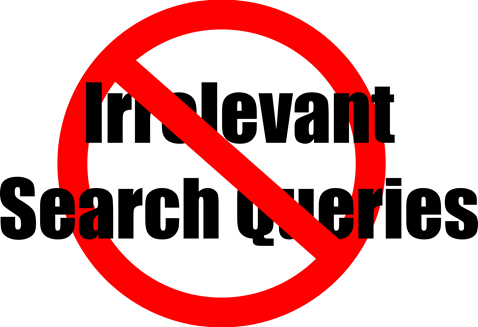Defining Negative Keyword Match Types

An essential and fundamental step in creating your campaigns and ad groups is building and adding your keyword lists. Any keyword you add should, of course, be related to the product or service you’re offering. The goal is when a potential customer is searching for a solution your ad will show, and then lead them to your site.
Unfortunately, search advertising isn’t always that simple. A customer doesn’t always know exactly what they are looking for or what they need. They may try a couple of searches and click a couple of ads before they narrow down what they are looking for. If they are looking for your product or service – great – let’s make sure we are showing them the most relevant ads and content available. If they are not, we want to ensure we do not show for their query and save a couple of cents (or dollars) depending on the keyword they are using

Here we will discuss the difference of negative match types and how they work:
Negative Broad
A negative broad-matched keyword, as Google defines it is, “a keyword setting that allows you to exclude your ad for searches where every word, in any order, of your keyword phrase appears in the search.”
If a keyword is Negative Broad, then your ad will not show anytime the entire term is used within a search query. For example, if your negative is running shoes, your ad will not appear for someone searching for “shoes for running” or “running shoes deals”. However, when used correctly, this can filter out a lot of different variations. Also, you should remember that this will not prevent ads from showing for variations of the word. That means that if you want to exclude both running shoe (singular version) and running shoes you need to add in BOTH as negative keywords. Last but not least, it’s important to note that Negative Broad match will not restrict ads from showing if someone searches on only one of the words. So if someone searches for flat shoe you will still appear, as the word shoe on its own is not a negative.
Example: negative broad match keyword – red heels
Possible searches:
- red high heels – WOULD NOT SHOW
- SJP Heels – WOULD SHOW
- high red heels – WOULD NOT SHOW
- SJP high red heels – WOULD NOT SHOW
- heels red – WOULD NOT SHOW
Negative Phrase
A negative phrase-match keyword allows you to exclude your ad for searches that include the exact keyword phrase. Searches may include additional words, and the ad won’t show as long as the keywords are included in the search in the same order.
This match type works similarly to traditional search terms in that it will exclude the phrase. A negative keyword is designated as phrase match when quotations are used around the phrase. Keep in mind that if someone searches for only one of the terms in your selected phrase, your ad will still appear. For example, if your negative is “boutique hotels” and a user searches for luxury hotels, your ad will still appear. This also means that if additional words are used in the search query, such as boutique luxury hotels, your ad will still appear as boutique and hotels are not next to each other in the search query.
Example: negative phrase match keyword – “red heels”
Possible searches:
- red high heels – WOULD SHOW
- SJP Heels – WOULD SHOW
- SJP high heels – WOULD SHOW
- high red heels – WOULD NOT SHOW
- SJP high red heels – WOULD NOT SHOW
- heels red – WOULD SHOW
- red heels – WOULD NOT SHOW
Negative Exact
An exact-match keyword allows you to exclude your ad for searches of the exact keyword phrase—without extra words. Your ad may still show for searches that include the keyword phrase with additional words.
In March of 2017, Google announced that exact match keywords are not longer exact match, meaning your ads could be triggered by variants of the keyword, similar to phrase and broad keyword terms – except for when it comes to negative terms. Please keep in mind that this match type will eliminate very little traffic as it only excludes searches for the exact term(s) in the order they are used.
To designate a negative term as Negative Exact, include [ ] around the term. If someone uses any other terms in his or her search, your ads will still appear. For instance, if your negative is [blue handbag] and someone searches for overnight blue handbag your ad will still appear as it does not match the negative term exactly.
Example: negative exact match keyword – [red heels]
Possible searches:
- red high heels – WOULD SHOW
- SJP Heels – WOULD SHOW
- SJP high heels – WOULD SHOW
- high red heels – WOULD SHOW
- SJP high red heels – WOULD SHOW
- heels red – WOULD SHOW
- red heels – WOULD NOT SHOW
Note: Close variants (any misspelling, singular or plural form, acronym, stemmings, abbreviations of the keyword) do not apply for negative keywords. So, should you want to block any variant too you have to add them separately as a negative keyword.
*Tip: In Google negative phrase cannot be longer than “10 words”. This includes single letter and pronouns (a, it, the, she, he, we, etc.)

Both Google & Bing allow the addition of negative keywords at the campaign and ad group levels. However, if you use multiple levels, the lowest level negatives override those at the higher levels.
If you haven’t added negative keywords into your account yet, and you’re not sure where to start, begin with running a Search Query Report to review what users are searching on to get to your ads. Remember, the report only shows information for those that have clicked on your ad.
You will also want to eliminate irrelevant traffic that may not have clicked yet so do a little research to see what other terms people might be using. Lastly, if you haven’t gone through your negative keyword list in a while, you might want to take some time to review what is currently in the account. As your business changes and some keyword popularity changes, negatives aren’t always updated so while terms might have made sense to exclude in the past, they may be relevant now.
——————–
2010 original post was brought to you by Erin Sellnow, a former Account Supervisor at Hanapin Marketing.



